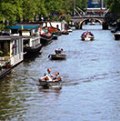
A (very brief) Guide to Amsterdam
Amsterdam is the capital of the Netherlands, even though neither the Dutch government nor the head of state resides in Amsterdam. The largest city in the Netherlands is also the country’s biggest tourist-draw.
Most of Amsterdam’s top attractions date from the city’s heyday during the seventeenth century when it was a financial and political powerhouse. Most of the cities’ famous canals and harmonious architecture stems from this era.
Predominant Architecture:
The dominant styles in downtown range from the Renaissance styles to 19th century neo-classicism, but there are also fine examples from Medieval to Modern architecture.
Places to see:
Amsterdam’s Canals: The many canals are lined with beautiful, mostly 17th century houses. While the canals were built for economical reasons, they are now Amsterdam’s biggest tourist attraction.
Rembrandt Square: This popular and often crowded square was originally created in 1668 as the Butter Market. A statue of the famous Dutch painter Rembrandt graces the center of the square.
Anne Frank House: The Anne Frank House – the hiding place of the Frank family who tried to escape the Nazis – is now a museum. On display are a facsimile of Anne Frank’s famous diary.
Van Gogh and Rembrandt Museums: Amsterdam’s most popular museums, boast over 200 works of the famous Dutch painters.
Waag: This 15th century building originally functioned as one of Amsterdam’s three main entrance gates. It was later converted into a weigh house, which gave its current name.